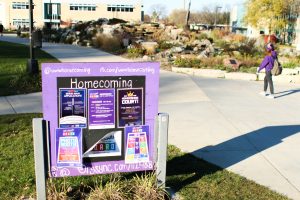By Kimberly Wethal
Nov. 11, 2015

Concerns were raised by students orgs during a discussion occurring in the past weeks about the future of the Minneiska Springs water feature located outside the University Center along the Wyman Mall..
The discussion, which took place at the first Campus Landscaping and Planning Committee (CL&PC) meeting of the semester, suggested the idea of putting a 50-foot buffer around the water feature in order to preserve the landscaping and tranquility of the area.
The grounds crew faced issues with cleaning and maintaining the water feature due to the volume of signage and activities crowding the area, said Peter Jacobs, CL&PC member and Geography/Geology department chairperson.
The buffer would be an area with imaginary boundaries, and would prevent any advertising and signage from being put up within the 50-foot radius, along with preventing student organizations from holding events and fundraising within that area.
“[It’s ideal that] the campus landscape would be open and available to everyone for all to enjoy without certain groups infringing on rights of others,” Jacobs said.
Preserving the tranquility of the area means keeping the area surrounding the water feature a place for quiet study, relaxation, observation and photography.
Whitewater Student Government (WSG) President Allison Hetz says there’s another way to give students a quiet place to study on campus without disrupting the flow of traffic and activity around the water feature.
“My counter-argument to that [reason] is that we have a lovely sitting area … where if you want to sit there to look at the fountain, [you can],” Hetz said. “The other thing is that area has been there for a while for student involvement, and especially with tour groups and new students coming through there, we want to showcase all of the activity on this campus.
“So I thought, if students that want to be in peace, that’s wonderful, but there’s other peaceful places on campus,” Hetz said.
A buffer this size would reach out over the sidewalks of Wyman Mall adjacent to the water feature, leaving little sidewalk space near the entrances of Hyland Hall, Roseman Hall and the University Center to be used for signage and activities.
Others discussed possible buffer sizes were of 100 feet and 150 feet.
WSG has taken a position on the discussion’s proposal after Sen. Thomas Kind, a CL&PC student representative, brought it to their attention during a meeting two weeks prior. The next week, 18 senators unanimously passed a resolution, written by Sen. Braden Chester at their Nov. 2 meeting stating their support for allowing student organizations to continue using the space.
Chester, who is not a part of the CL&PC committee, took the initiative of writing the resolution, simply because he’d been a part of WSG for a longer period of time than Kind.
“My biggest concern with this potential new policy that they’re thinking about implementing is the impact it could have on student organizations,” Chester said. “Just this week we have a Teeter-Totter-athon with Lambda Chi Alpha … there’s no other location that really meets the needs for students there. There’s no other place on campus that would have as much traffic as the UC.”
From April 2014 through October 2015 there have been 40 different groups have reserved space on the north side of Wyman Mall in 58 days, according to the University Center’s reservation data. The number of groups doesn’t include activities taking place in the area without reservation.
The committee is suggesting any advertisements and activities be held in other visible, high-traffic areas on campus.
More discussion on the topic taking place at the latest CL&PC meeting on Monday, where Hetz said later on Monday some of the committee members had changed their position on the issue.
Vice chancellor of academic affairs and CL&PC member Jeff Arnold says a reasonable compromise between the two competing viewpoints on the issue can be achieved.
“I think we still have a need for students to locate their activities there, and at the same time, we need to protect the water feature,” Arnold said. “There’s a lot of planting, and we don’t want a lot of activity in there that would damage the work that’s being done there, so that’s the compromise that we need to work out.”

